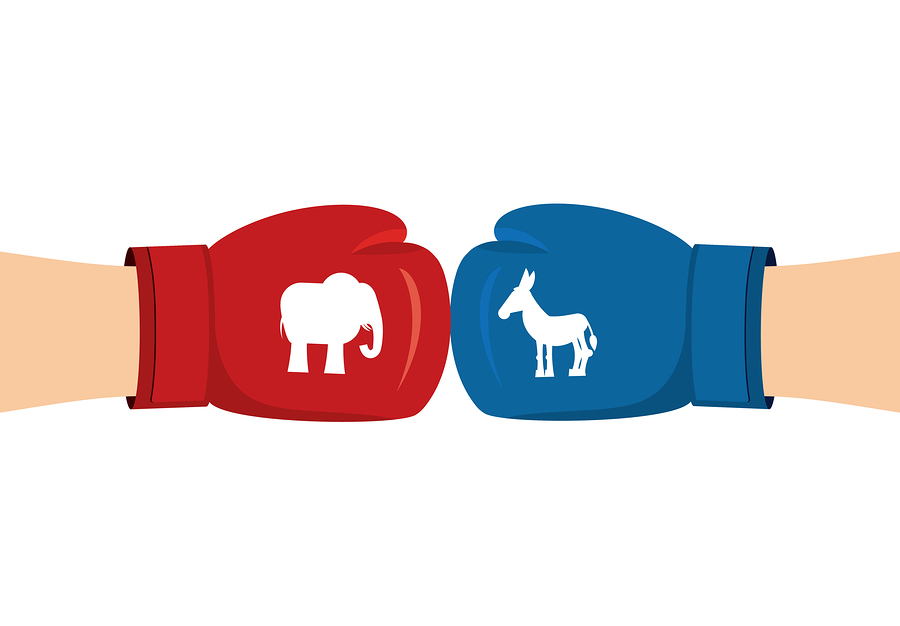 It’s Kivi here . . .
It’s Kivi here . . .
At Nonprofit Marketing Guide, we are all about helping communications directors do the best job possible for their organizations and to do the work with purpose, enthusiasm, and integrity.
We are also very much about being pragmatic and keeping it real . . . which brings us to our recent presidential election.
As nonprofit communicators, we cannot ignore the tumultuous political times we live in. The news media has dubbed the divide the “Two Americas” and for lack of a better term, we’ll go with that.
It’s true that some nonprofits work hard to be apolitical or to stay neutral. But for many others, public policy — and therefore politics — is central to your advocacy mission, and therefore embedded into your communications strategies. And regardless of where your organization falls on this spectrum, it is made up of employees, board members, donors, and volunteers who likely hold very strong opinions about the 2016 presidential campaign and our president-elect.
So, how do you, as a communications professional, deal with this “Two Americas” reality? How does it affect your work informally and formally?
Peter Panepento, our media relations advisor, would like to develop a new webinar for communications and fundraising staff on this issue.
But we need your feedback to help frame these conversations. How would you describe the challenge? What questions do you have about doing your work within the “Two Americas”? Please add your thoughts and perspectives to the comments on this post.
Now, I’ll turn this post over to Peter, who will share his perspective with you . . .
With the contentious 2016 campaign and the election of Donald Trump as President, America seems more divided than ever.
For nonprofit communicators, this divide creates a complex set of challenges — and we need to begin plotting a new path forward that helps us speak more effectively with those on both sides of the chasm.
Today, we’d like to invite you to help chart that path.
But, first, let’s look at how we arrived here.
One of the central themes of Mr. Trump’s campaign was his promise to build a wall along our country’s border with Mexico. But while many were fixated on this wall during the campaign, we have been ignoring a more ominous wall that has been building, brick by brick, over the course of several years.
It’s the figurative wall between two Americas.
Many in the nonprofit world have been decrying the deep divisions that exist between the urban, liberal culture that is based largely on our coasts and the more rural, conservative culture that permeates much of our heartland.
The problems that our organizations are looking to address — issues of economic and racial inequity, hunger, education, the environment, and health — affect large numbers of citizens on both sides of this divide. Often the solutions to these problems bring benefits to all — regardless of where they live or the color of their skin.
And yet we spend much of our time communicating with those within our own bubbles.
As I read the responses from liberal-leaning nonprofit leaders on social media and elsewhere in the days after the election, I’m seeing anger and frustration thrown at Trump voters. I’m seeing genuine expressions of fear and panic. I’m seeing blame lobbed at third-party candidates and the FBI.
More conservative voices, meanwhile, are celebrating and saying that everyone else needs to get over it.
The tenor of these messages is dispiriting — and it’s also revealing.
In venting emotions about the election’s results, we risk insulting — and further alienating — a large population of people whom we need on our side as we work to achieve our missions.
Unconsciously, we are labeling them as others.
In turn, they are labeling us as part of the problem.
A Lack of Trust
This problem is particularly problematic for liberal-leaning nonprofits.
Many of those who voted for Donald Trump in places like Michigan, North Carolina, Pennsylvania, and Wisconsin did so because they feel ignored and looked down upon. They feel as though nobody in Washington is respecting their values or needs. And they feel as though they are being lied to and taken advantage of by the so-called elites who run the show.
Many of these voters are living in communities that have seen better days. They have watched economic opportunities vanish and their education system fail. And they feel like nobody — not government, politicians, corporations, or nonprofits — has taken steps to find real solutions.
Many nonprofits have the power to do much more to engage this important population in finding solutions to these problems. Yet to achieve that requires reaching out instead of adding to the rhetoric that labels them as deplorables.
Yes, there was a current of racism, xenophobia, and misogyny in Mr. Trump’s campaign that was unacceptable. And we should continue to stand against it. But we cannot cut through that and change minds by simply denouncing it. Or by broad-brushing or stereotyping the people who supported his campaign as racist and sexist.
Instead, let’s use these results as a call to action.
Listen and Learn
The best way to combat these attitudes and push for the greater good is to find areas of common ground.
And this begins with how we listen and how we speak.
As nonprofit communicators, we should see the election’s result as an opportunity — and challenge — to take time to listen thoughtfully to those who have different perspectives. It’s an opportunity to learn about their motivations and their pain and look for shared goals.
Further, if we really want to address issues like economic opportunity, education, and global warming, our communications must engage more than a few selected audiences.
This doesn’t mean we should neglect our supporters. But we can expand those audiences by thinking about our work differently — and find ways to engage a full range of people in it.
We also have to rethink our tone to make sure we communicate with authenticity, not arrogance. All too often, in our official communications, in our fundraising, and in our advocacy, we are largely speaking directly to the elites.
So much of what comes out of the communications and fundraising departments at nonprofits and foundations is created for those who are like us — and it’s often littered with jargon and dense language that, to those outside of our bubbles, raise red flags and suspicion.
When we speak like insiders, we send a strong signal that we’re part of the same club of elites who don’t truly care about the needs of many of the people we are actually trying to help.
That leads to nonprofits being lumped in with the establishment groups that aren’t always our allies. Worse, it leads to mistrust among the very people we are working so hard to help.
And that’s a shame because quite often this work would not only benefit from greater support — it would improve the lives of many people who see it as working against their interests.
It’s a conundrum — and it’s one that nonprofits helped create.
But it’s not too late for us to take a new approach — and to take the message we heard on Election Day to heart.
Coming Together
As a starting point, Kivi and I have been talking about creating a webinar that equips nonprofit communicators with tools to help them speak more effectively to the two Americas — with the goal of helping us rebuild trust with those on the other side of the divide and reaching more people.
We have some ideas on what to address, but we’d like you to help us shape it.
What are some of the big questions your organization is facing in the wake of the contentious election? What tactics have worked well for you in reaching out to potential supporters who might not share your organization’s ideology?





